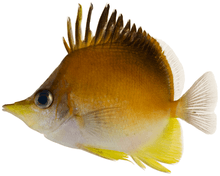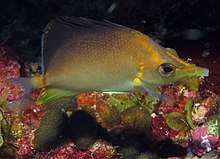Prognathodes aculeatus
Prognathodes aculeatus, the longsnout butterflyfish, is a species of butterflyfish found in tropical West Atlantic waters. It is also known as the butterbun, the Caribbean longsnout butterflyfish, or Poey's butterflyfish. This species should not be confused with the banded longsnout butterflyfish (Chelmon rostratus).[1]
| Longsnout butterflyfish | |
|---|---|
 | |
 | |
| Scientific classification | |
| Kingdom: | Animalia |
| Phylum: | Chordata |
| Class: | Actinopterygii |
| Order: | Perciformes |
| Family: | Chaetodontidae |
| Genus: | Prognathodes |
| Species: | P. aculeatus |
| Binomial name | |
| Prognathodes aculeatus (Poey, 1860) | |
| Synonyms | |
|
Chaetodon aculeatus | |
Scientific name

The longsnout butterflyfish was first described in 1860 by two scientists: Felipe Poey y Aloy and Albert C. L. G. Günther. Between them the fish was given three separate scientific names each one in a different genus. It was again described in 1880 by Sauvage who gave it yet another scientific name.
Description
An average of 2 to 3 in (5–7.5 cm) long, the longsnout butterflyfish is commonly known for its namesake long snout that is much more distinctive than those of similar species. They also have a dusky to yellow colored stripe that runs almost vertically from the top of the head to the eyes (unlike the stripes on other butterflyfishes which extend past the eyes).
The upper half of the longsnout butterflyfish is yellow that changes to orange and again darkens to brownish-orange. The dorsal fin of the fish is usually black.
Habitat and range
Fairly common throughout its range, the longsnout butterflyfish is found on natural and artificial reefs, usually 30 to 200 ft (10–60 m) in depth, off Florida, in the Gulf of Mexico, in the Caribbean Sea, and off the coast of Venezuela.
Behavior
Longsnout butterflyfish are much more solitary than many other members of their family. They also inhabit deeper reefs and spend much of their time foraging in recesses for invertebrates. It is also known to eat the tube feet of sea urchins and tube worm tentacles. Unlike many other members of its family, the longsnout butterflyfish does not pick parasites from other fish.
References
- "Species Prognathodes aculeatus Poey 1860". FishWisePro. 1860. Retrieved 19 April 2020.
- Humann, Paul and Ned Deloach, Reef Fish Identification Florida Caribbean Bahamas New World Publications Inc., Jacksonville, Fl; pp. 32–33
- IUCN 2007. 2007 IUCN Red List of Threatened Species. <www.iucnredlist.org>. Downloaded on 28 September 2007.
External links
- Photos of Prognathodes aculeatus on Sealife Collection
